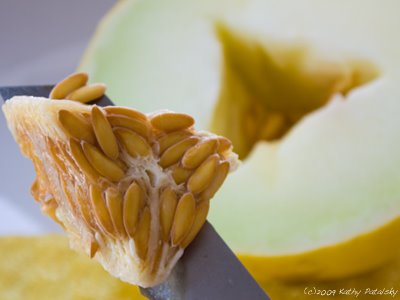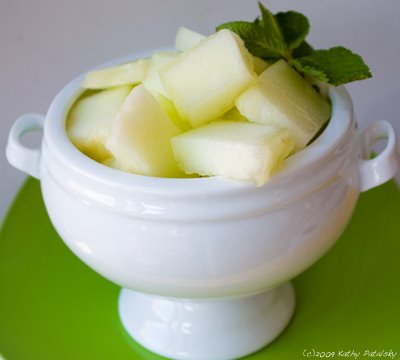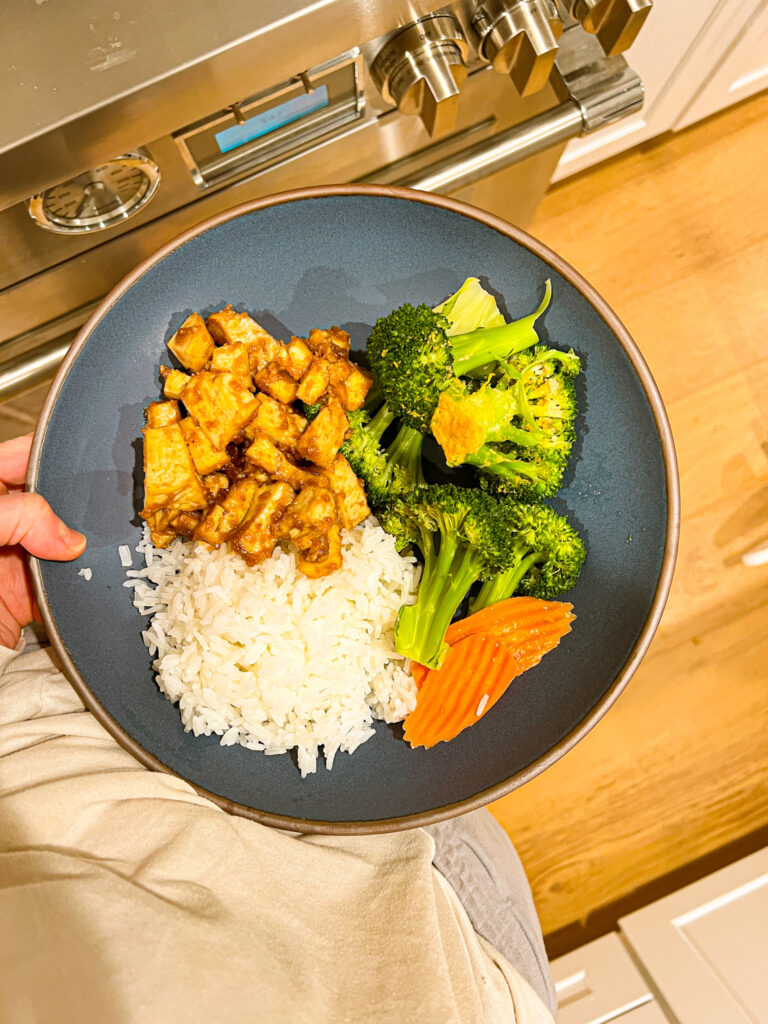Bright beautiful round melons are a hydrating treat for everyone. Melons are low in calories and high in a few important nutrients like Vitamin C and potassium. But sometimes shoppers shy away from buying melons simply because of their size, weight and mystery of what is on the inside!
mini orange-flesh melon bowl..

Many Melons. There are many varieties of melon. The most popular and common in the US are Honeydew, Cantaloupe, Casaba and Watermelon. Ahead, I'll discuss how to tell melons apart and a few tricks to pick out the best melon.

Click ahead for the 101 on Melon varieties, melon nutrition facts and a few fast and tasty recipes to jazz-up your raw melon bowl....
Tuscan Cantaloupe with blueberries:
Melon Nutrition
Melons range in calories from 40-80 calories per cup, depending on the melon type and its degree of ripeness. Riper melons contain more sugar.
In general, melons are high in fiber, Vitamin C, potassium, and a few B vitamins like B6. Cantaloupe melons are considered very nutrient-dense because of their high Vitamin A content. One cup on cantaloupe contains 120% RDA of Vitamin A. All that and only around 55 calories.
Casaba: Bright yellow rind, light whitish yellow on the inside. Seeds are easy to scoop out. Has a sweet pure flavor. Easy to add flavors to. Neutral sweetness. Very smooth and hard rind-a few creasing lines. Slightly oval shaped.
Cantaloupe: Rough criss-crossed tan rind. Becomes softer as it ripens. Inside flesh is bright honey-orange. Seeds are easy to scoop out. Sweet flavor with a very unique sweet accent all its own. Perfectly round.
Watermelon: Rind is green with white lines. Smooth. Hard. The inside flesh is bright pink-red. Very watery and grainy texture. Very sweet, yet the high water content cuts the sweetness. Crisper bite than other melons. Seeds are embedded and tricky to remove before serving. Seedless options are available. Oval shaped. Exotic seedless watermelons are smaller and round.
Honeydew: Whitish-green-yellow rind. Smooth and hard. Inside flesh is whitish green. Very succulent and almost ripe-peach like when at its height of ripeness. If cut too soon it can be hard and lacking in sweetness. Seeds are easily scooped out. Delicious dessert-sweet flavor. Perfectly round.
Melon Selection
It's easy: Smell, listen, feel.
Smell the melon. More aromatic smell is a ripe and flavor sign.
Listen: Knock on the melon. A hollow sound is a good sign.
Feel: Feel the rind. Look for a nice firmness with a tinge of tenderness. Too hard or too soft melons should be avoided.
Melon Digestion: Food Combining Controversy
The Food Combiners say this:
"Melons are such a perfect food for humans that they require no digestion whatsoever in the stomach. Instead, they pass quickly through the stomach and move into the small intestine for digestion and assimilation.
But this can happen only when the stomach is empty and melons are eaten alone, or in combination only with other fresh raw fruits.
When consumed with or after other foods that require complex digestion in the stomach, melons cannot pass into the small intestine until the digestion of other foods in the stomach is complete.
So they sit and stagnate instead, quickly fermenting and causing all sorts of gastric distress."Source: Daniel Reid."
My thoughts:
The 'other side' anti-food combiners, say that our stomachs can handle just about anything and eating melon alone is not necessary. I see truth in both sides. For optimal gastric comfort and efficiency I would say eat melon by itself or at least with other sweet fruits (like in a sweet fruit salad). But if you eat a few slices of melon at say a big buffet or event, don't freak out. The melon may not digest out of the stomach as quickly, but it will digest. The only time I could see a problem is if you are eating a big meal with a lot of melon. Then you will most likely experience some stomach discomfort that could have been avoided by not eating the melon.
Jazz-Up Your melon Recipes
Lime-Salt melon
Per melon
De-rind and cube, ball or slice melon.
Add the juice of 1 lime to melon. Mix well.
Top with a few sprinkles of course sea salt.
*Works best with sweet melons like honeydew.
Agave-Olive Oil melon
Per melon
De-rinds and cube, ball or slice melon.
Add 3 tablespoon honey or agave syrup to melon in bowl.
Mix well.
Plate and drizzle with a few teaspoons of olive oil.
Sprinkle with sea salt (optional)
Minted Melon
Per melon
De-rinds and cube, ball or slice melon.
Chop ½ cup of fresh mint.
In a large bowl toss melon with mint and a pinch of natural sugar or agave.
Plate and garnish with mint sprigs.
Spiced Up Melon
Per melon
De-rinds and cube, ball or slice melon.
Add melon, 2 teaspoon cayenne and a drizzle of olive oil to a bowl.
Mix well.
For spicy-sweet flavor add a few drizzles or a natural sweetener like agave.
Melon Skewers
De-rinds and cube or ball melon.
Add to skewers. A mix of melon varieties looks best.
Sprinkle skewers with any of the above ingredients.
Melon-addition ingredients list:
honey or agave
natural sugar
mint
olive oil
sea salt, course is best
cayenne




















